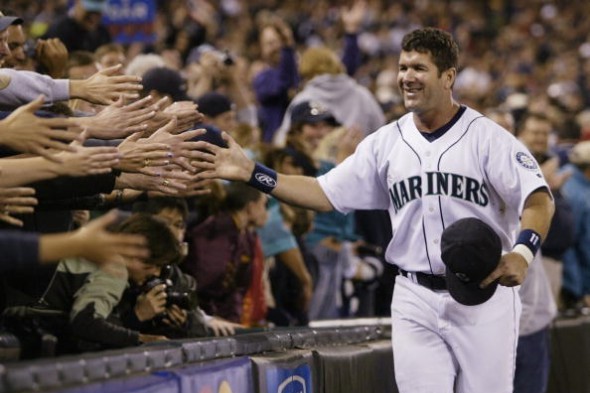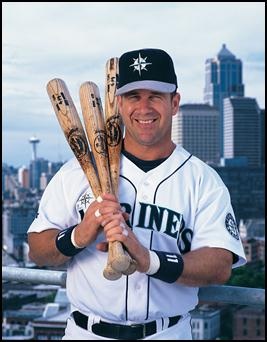
When Edgar Martinez in January landed on 58.6 percent of Baseball Hall of Fame ballots, a major increase of 15.2 percent over his showing in 2016, he set in motion a process that will play out Saturday at Safeco Field: The club will, for the second time in more than 40 years, retire Saturday night the jersey of a former player, Martinez’s No. 11.
A year ago this month, shortly after he was inducted into the Baseball Hall of Fame in Cooperstown, NY., with a record 99.7 percent of the vote, Ken Griffey Jr. had his No. 24 removed from circulation. That was an easy call based on the franchise’s guidelines for number retirements.
A player is eligible to have his jersey retired only if he has been elected to the Hall of Fame or – and this is the caveat – if he has come close to election. What constitutes close?

Hall of Fame candidates must receive at least 75 percent of the vote for election. With a new base of 58.6 (which can go down as well as up), Martinez still requires a 16.4 percent increase to reach the minimum (he has two years remaining on the 10-year writers’ ballot).
Several days after the January vote, Mariners executives made a plan.
“It was a conversation that we had, and then when the Hall of Fame vote came out, it was a relatively quick call,” club president Kevin Mather said when the team made the jersey retirement announcement. “Our board of directors had to approve it. It was a relatively easy answer once he got over 50 percent.”
Exceeding 50 percent bodes well for Martinez. With the exception of four players since 1936, every nominee who received 50+ percent of the vote at least once during his time on the ballot eventually was elected. One of the four, Curt Schilling, really doesn’t count since he didn’t become HOF eligible until two years ago. The other three:
| Player | Career | Main team | HOF credentials |
|---|---|---|---|
| Gil Hodges | 1943-63 | Dodgers | 8-time All-Star, 3 Gold Gloves |
| Jack Morris | 1977-94 | Tigers | 5-time All-Star, 1991 World Series MVP |
| Lee Smith | 1980-97 | Cubs | 478 saves, 7-time All-Star |
Hodges appeared on the ballot 15 times between 1970-84 and received more than 50 percent of the vote 10 times with a high of 63.4 percent in 1983. Not only did Hodges fail to garner the necessary 75 percent, even the Veteran’s Committee has rejected him annually since he left the ballot. Martinez’s main goal now: Don’t pull a Gil Hodges.
Morris received more than 50 percent of the vote five times on 15 HOF ballots with a high of 67.7 percent in 2013. Also 15 times on the ballot, Smith received a high of 50.6 percent in 2012, but never higher than 47.7 percent in any other year.
So maybe Martinez is trending toward election, as the Mariners hope. Or, maybe he’s not. Hodges, Morris and Smith remind us that things can go awry. Martinez might have already come as close as he’ll ever get.
“Edgar Martinez is the string that binds together our franchise history,” said Mather. “He has worn a Seattle uniform in parts of four decades, and this (jersey retirement) will assure that his number will be proudly displayed in Safeco Field forever. He is most deserving of the ultimate honor the Mariners franchise can bestow.”
The ceremony won’t merely be about retiring jersey No. 11. It will be about providing another boost to Martinez’s hall candidacy. His case – seven All-Star appearances, two batting titles, five designated hitter awards, five Silver Sluggers – is certainly impressive, but has left him shy of the game’s highest accolade.
The Mariners, who would be able to create dozens of promotions if Martinez entered Cooperstown, have been creative and persistent in their research to push against the two obstacles holding him back.
First, he was primarily a designated hitter. No player who was primarily a DH has been elected. Second, while Martinez amassed some impressive numbers, he failed to achieve any of the common standards – 3,000 hits, 500 home runs – by which hitters are usually judged.
So the club over the past five years has attempted to get voters to think outside the box and judge Martinez not on what he failed to do, but on what he did, some of which follows.
Mike Schmidt (2,234), Willie Stargell (2,232), Joe Sewell (2,226), Joe DiMaggio (2,214, Bill Terry (2,193) and Chuck Klein (2,076) are all in the Hall of Fame. All had fewer hits than Martinez’s 2,247.
Al Simmons entered the Hall of Fame with 307 home runs, Rogers Hornsby with 301 and Klein with 300. Martinez hit 309.
Martinez had a higher career OPS (.933) than Hall of Famers Earl Averill (.928), Tris Speaker (.928), Duke Snider (.919), Mike Schmidt (.907), Griffey (.907), Willie McCovey (.889), Willie Stargell (.888), Wade Boggs (.858), Roberto Clemente (.834), Tim Raines (.817), Craig Biggio (.796) and Cal Ripken (.788).
Johnny Bench (3,644), Yogi Berra (3,643), Johnny Mize (3,621), Enos Slaughter (3,599) and Terry (3,252) all entered the Hall of Fame with fewer total bases than Martinez’s 3,718.
Among retired players since 1945 with at least 7,500 plate appearances, Martinez is one of only four with a career on-base percentage of at least .418 (Barry Bonds, Mickey Mantle and Frank Thomas). Mantle and Thomas are Hall of Famers, and no more needs to be said about Bonds.
Although Martinez didn’t have that one obvious mega stat to impress voters, he can probably feel confident about Cooperstown based on what happened to Bert Blyleven, who made the HOF in 2011 in his 14th year of eligibility.
Blyleven first appeared on the ballot in 1998, receiving 17.5 percent of the vote. The next year, that figure sagged to 14.1. Blyleven didn’t get half the votes necessary for induction until 2006, his ninth year of eligibility.
Then the blogosphere took over and a campaign on Blyleven’s behalf created an upwell of support for a pitcher who fanned 3,700 batters and tossed 60 shutouts. Forced to consider new information, or at least reconsider old information, voters ultimately looked past Blyleven’s so-so .544 winning percentage and awarded him 79.7 percent of the vote.
One stat underscoring Martinez’s ability as a hitter: Only 16 in the history of the game retired with a batting average above .300, an on-base percentage above .400, and a slugging percentage above .500. That’s 16 out of 19,101, Baseball Reference’s latest count on the number of men who have played in the majors.
That group includes Ty Cobb (.366-.433-.512), Babe Ruth (.342-.474-.690), Lou Gehrig (.340-.447-.632) and Ted Williams (.344-.482-.634), Hall of Famers all.
It does not include Hall of Famers Griffey, Honus Wagner, Nap Lajoie, George Sisler, DiMggio, Mantle, Willie Mays, George Brett, McCovey and Kirby Puckett.
It does include Martinez, who retired following the 2004 season with a .312 batting average, a .418 on-base percentage and a .515 slugging percentage.
Of the 16 players in the .300-.400-.500 club, only two are not in – Martinez and the ineligible Shoeless Joe Jackson.
A marginally more exclusive list includes 15 players, those with 300+ home runs, 500+ doubles, 1,000+ RBIs and a career batting average above .300. Hank Aaron, Ruth and Mays top this group, and everybody in it who is eligible for the Hall of Fame has been enshrined – except Martinez.
A more exclusive club includes the 10 players with 300+ home runs, 500+ doubles, 1,000+ walks, a batting average above .300 and an on-base percentage above .400. Five of the 10 – Stan Musial, Hornsby, Ruth, Gehrig and Williams – are in the Hall of Fame. Chipper Jones, Todd Helton and Albert Pujols aren’t yet eligible, leaving Martinez and Manny Ramirez, who hit .312 with 555 home runs but served two drug suspensions, on the outside looking in.
Whether the club’s plunge into statistical exotica will sway Baseball Writers Association of America voters toward Martinez next year or the year after, we can’t say. We can say that Blyleven did not pad his resume one iota between 1998 and 2011, and yet his approval rating among HOF voters shot up about 66 percent.
Saturday’s number retirement will provide another opportunity to remind voters of Martinez’s worthiness.

5 Comments
I’m convinced! Those are some historic numbers. I think he will get in eventually. Everybody loves Edgar.
Well, then, with your vote and everyone else’s, he should have run for mayor.
If David Ortiz gets into the Hall before Edgar … (seethes)
Fully confident Edgar will get in. During his lifetime no less. Shoeless Joe really should be in the HOF.
Funny how all three players elected to HOF have dirty pasts. Pudge and Baggs were both juicing at some point in their careers and Raines was a coke-head- a guy who slid in head first so as to not break the cocaine vials in his back pocket… yet, Edgar, clean as can be (except an unfounded suspicion of a few greenies by Shane Monahan-yeah, who?), is respected throughout baseball by pitchers as being the toughest out in the AL during his years. Its getting to be like the Rock and Roll HOF-well, not THAT terrible, but…we want our Gar in the Hall!